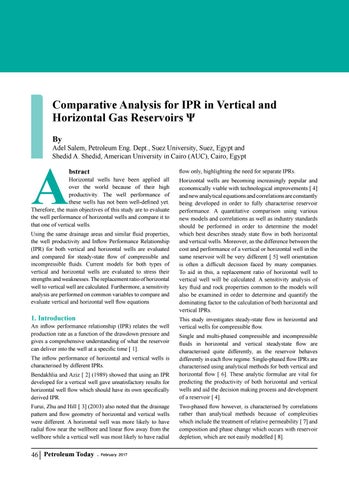Comparative Analysis for IPR in Vertical and Horizontal Gas Reservoirs Ψ By
Adel Salem, Petroleum Eng. Dept., Suez University, Suez, Egypt and Shedid A. Shedid, American University in Cairo (AUC), Cairo, Egypt
A
bstract
flow only, highlighting the need for separate IPRs.
Horizontal wells have been applied all over the world because of their high productivity. The well performance of these wells has not been well-defined yet. Therefore, the main objectives of this study are to evaluate the well performance of horizontal wells and compare it to that one of vertical wells.
Using the same drainage areas and similar fluid properties, the well productivity and Inflow Performance Relationship (IPR) for both vertical and horizontal wells are evaluated and compared for steady-state flow of compressible and incompressible fluids. Current models for both types of vertical and horizontal wells are evaluated to stress their strengths and weaknesses. The replacement ratio of horizontal well to vertical well are calculated. Furthermore, a sensitivity analysis are performed on common variables to compare and evaluate vertical and horizontal well flow equations
1. Introduction
An inflow performance relationship (IPR) relates the well production rate as a function of the drawdown pressure and gives a comprehensive understanding of what the reservoir can deliver into the well at a specific time [ 1].
Horizontal wells are becoming increasingly popular and economically viable with technological improvements [ 4] and new analytical equations and correlations are constantly being developed in order to fully characterise reservoir performance. A quantitative comparison using various new models and correlations as well as industry standards should be performed in order to determine the model which best describes steady state flow in both horizontal and vertical wells. Moreover, as the difference between the cost and performance of a vertical or horizontal well in the same reservoir will be very different [ 5] well orientation is often a difficult decision faced by many companies. To aid in this, a replacement ratio of horizontal well to vertical well will be calculated. A sensitivity analysis of key fluid and rock properties common to the models will also be examined in order to determine and quantify the dominating factor to the calculation of both horizontal and vertical IPRs. This study investigates steady-state flow in horizontal and vertical wells for compressible flow.
Bendakhlia and Aziz [ 2] (1989) showed that using an IPR developed for a vertical well gave unsatisfactory results for horizontal well flow which should have its own specifically derived IPR.
Single and multi-phased compressible and incompressible fluids in horizontal and vertical steadystate flow are characterised quite differently, as the reservoir behaves differently in each flow regime. Single-phased flow IPRs are characterised using analytical methods for both vertical and horizontal flow [ 6]. These analytic formulae are vital for predicting the productivity of both horizontal and vertical wells and aid the decision making process and development of a reservoir [ 4].
Furui, Zhu and Hill [ 3] (2003) also noted that the drainage pattern and flow geometry of horizontal and vertical wells were different. A horizontal well was more likely to have radial flow near the wellbore and linear flow away from the wellbore while a vertical well was most likely to have radial
Two-phased flow however, is characterised by correlations rather than analytical methods because of complexities which include the treatment of relative permeability [ 7] and composition and phase change which occurs with reservoir depletion, which are not easily modelled [ 8].
The inflow performance of horizontal and vertical wells is characterised by different IPRs.
46 Petroleum Today
- February 2017





